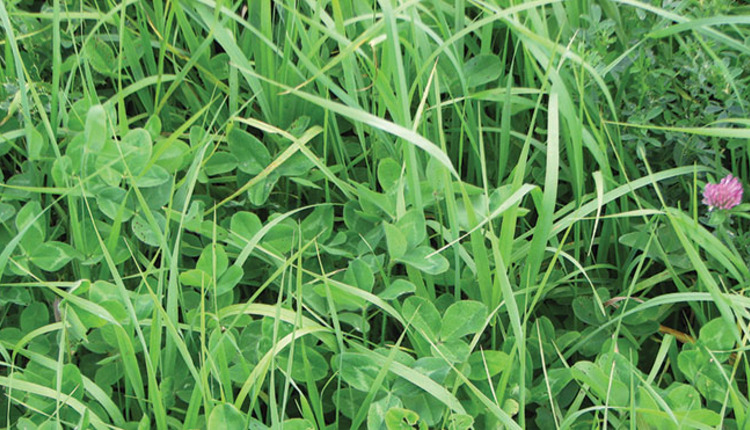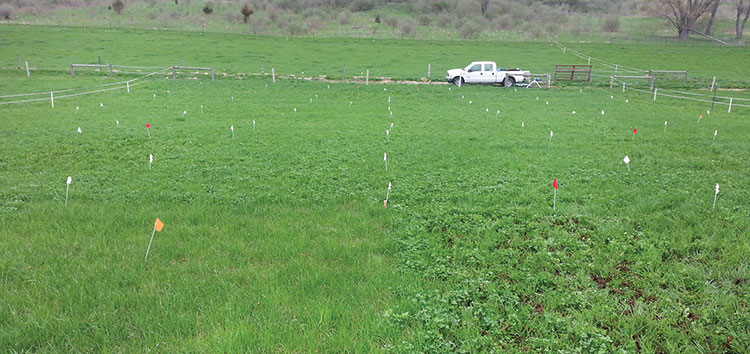
Grazing-based livestock producers frequently overseed cool-season grass pastures with legumes such as red clover, white clover, or alfalfa to increase forage quality, improve the seasonal distribution of forage production, and reduce the need for supplemental nitrogen (N). However, solid manure collected from bedded packs or liquid manure collected in pits must also be utilized on the farm, and nutrients contained in manure will improve pasture productivity.
The effects of applying manure to grass-legume pastures and the subsequent effects on legume persistence should be carefully considered because the forage quality benefits imparted by legumes may be more important than a boost in pasture productivity attributed to the manure. Determining how manure type, date of application, and pasture management influence pasture productivity and legume persistence will provide management guidelines for utilizing manure efficiently and maintaining legumes in rotationally-grazed pastures.

Liquid versus solid
Several factors influence how a mixed, cool-season pasture responds to manure application. The N in solid manure is primarily in nitrate form because much of the ammonia has been lost as a gas during storage. Conversely, the N in liquid manure is primarily in the ammonia form, which can be lost during application, particularly if the air temperature is high. An advantage of liquid manure is that it can enter the soil relatively quickly, potentially reducing N losses. An advantage of solid manure is its relatively slow rate of decomposition, which makes the N available to plants over a longer time period.
Plants can absorb N in either the nitrate or ammonia form, but typically take up nitrate-N more readily than ammonia-N. Grasses absorb N more efficiently than legumes due to their fibrous root system, and they exhibit a more rapid growth response. The manner in which the pasture is managed after manure is applied may also influence legume growth and persistence; harvesting a pasture for hay may impose further competitive stress on the legume.
Given these factors, scientists at the U.S. Dairy Forage Research Center, USDA Agricultural Research Service, conducted experiments to determine the response of an orchardgrass-red clover mixture to manure type and application date, and to pasture management. Orchardgrass was overseeded with red clover and clipped monthly the year before manure was applied. All treatments were supplied 60 pounds of N per acre except the None treatment (no N). Plots were grazed at the vegetative stage (three to four grass leaves) five times during the growing season, or harvested for hay (grass head emerged) in spring and then grazed at vegetative stage three times.
Higher productivity
The mean annual forage yield of an orchardgrass-red clover mixture grazed five times each year at vegetative stage and not fertilized with manure was 7,100 pounds of dry matter (DM) per acre. At the end of the grazing season, red clover was found in half of the rows in which it was seeded (50 percent stand). Applying either solid or liquid manure in April and grazing throughout the season enhanced annual forage yield by 500 pounds of DM per acre, a 7 percent improvement in productivity.
A red clover-orchardgrass mixture fertilized with solid or liquid manure in June or August produced 400 to 700 pounds of DM per acre less than a mixture receiving no manure. Whether manure was applied in April, June, or August, persistence of red clover that was grazed during the season at vegetative stage was reduced from a 50 percent stand (no manure applied) to a 30 to 45 percent stand. Mixtures receiving manure in the spring had greater annual yield due to greater grass growth, and mixtures receiving manure in mid- to late summer had lower annual yield due to a loss of clover.

Legume persistence suffers
A red clover-orchardgrass mixture harvested for hay in the spring and grazed at vegetative stage the rest of the season was equally productive as that grazed at vegetative stage throughout the season (7,100 pounds of DM per acre). Delaying harvest in the spring to hay stage, however, reduced clover persistence from a 50 percent stand (no haying or manure) to a 40 percent stand. Applying liquid manure to the mixture and following the same harvest regime reduced annual yield by 300 pounds of DM per acre due to a further decline in red clover persistence (50 to 30 percent).
The results indicate that there is no difference between solid and liquid manure with respect to their effect on pasture growth and legume persistence: Applying manure in the spring to a grazed grass-legume mixture will improve annual productivity, but at the expense of legume persistence. Applying manure in mid- to late summer did not improve annual production and further reduced legume persistence.
Producing hay from grass-legume pastures has a detrimental effect on legume persistence, but persistence is further reduced when manure is applied. Since one of the primary benefits of adding legumes to pasture is improved forage nutritive value, don’t apply manure to pastures with good legume stands, which is generally in the seeding year and the following year.

